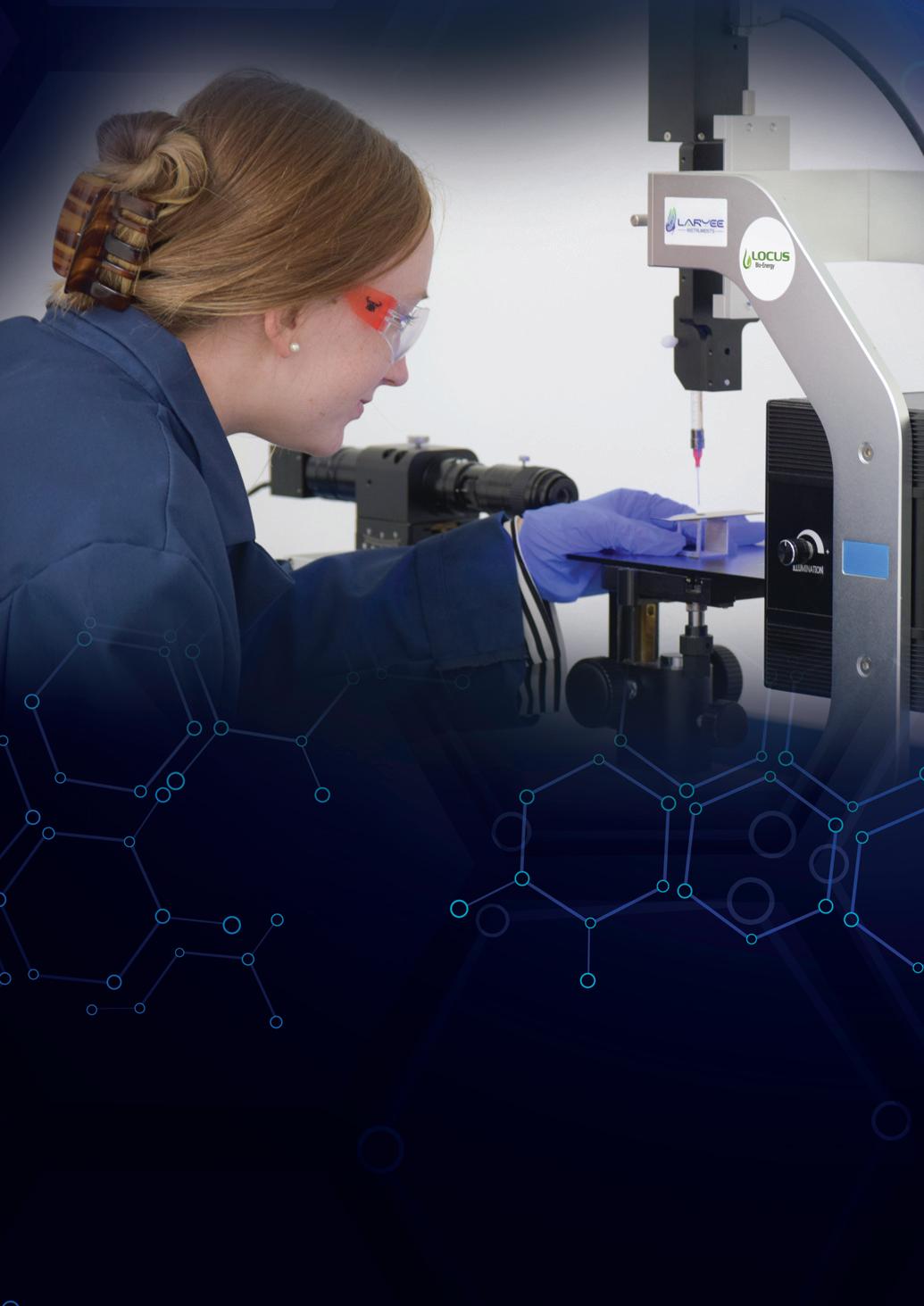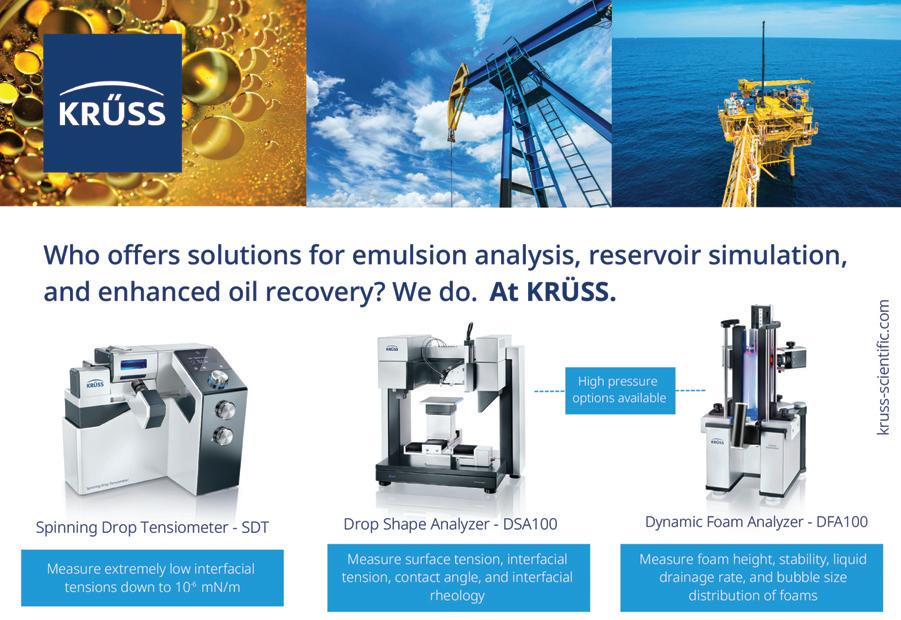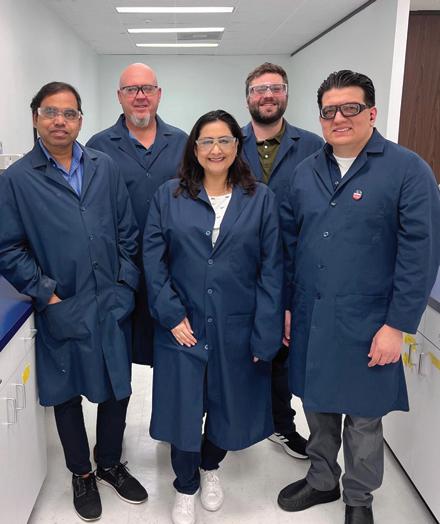






Locus Bio-Energy produces nature-derived biosurfactants which are globally recognised for outperforming traditional oilfield chemicals. Biosurfactants can address many oilfield production challenges - at a fraction of the dosage rate and cost. Dr Megan Pearl, VP of Technology, explained more to Hannah Barnett.

INthe oilfield, green chemistry often has the reputation of low performance and high cost.
Locus Bio-Energy’s biosurfactant technology is working to change that.
“We focus first on performance,” said VP of Technology, Dr Megan Pearl: ”Our goal is to deliver the best performing products at economical price points for key industry pain points. The biosurfactant technology we provide enables operators to achieve production objectives with lower dosage rates and faster returns – plus the added advantage of minimising their environmental footprint.”
Oilfield surfactants are traditionally used to enhance oil production. Conventionally used surfactants are typically sourced
from non-renewable, petroleum-based feedstocks and raw materials. In contrast, biobased surfactants range from partly to wholly derived from biological products, renewable domestic agricultural by-products, or forestry materials.
Biosurfactants are a class of wholly biobased surfactants comprised of highly complex molecules with unmatched multifunctionality and sustainability. Despite decades of research and promising potential, biosurfactant adoption in the oilfield was previously limited by prohibitive production costs and scalability.
“What differentiates Locus Bio-Energy from our competitors and predecessors is our approach to the market,” Dr Pearl explained. “We understand uninterrupted production is paramount to operators, s o we manage all stages of development

and testing internally to lower their barrier to adoption. Rather than providing one-size-fits-all chemistry, we’ve refined the product development process to deliver comprehensive biosurfactant solutions, complete with performance evaluations customised to each reservoir’s unique conditions.”

Biosurfactants can be tailored to various applications like hydraulic fracturing, paraffin control, enhanced oil recovery, wellbore remediation and more. Since the company’s launch in 2017, it has sold over two million gallons of biosurfactant-based products for a variety of applications across diverse U.S. basins.
“Early on, we focused on conventional applications, like huff and puff, that were low volume, low risk and low cost for the operator,” said Dr Pearl. “This was so that we could demonstrate proof-of-concept to the industry. As our reputation for proven biosurfactant technology grew, our product lines likewise evolved to include higher volume unconventional applications like hydraulic fracturing.”
With its expanding Texas teams and recently completed 5,000 square foot laboratory renovations in The Woodlands, Locus Bio-Energy has both the instrumentation and expertise to continue developing innovative biosurfactant-based solutions for a growing customer base.
The complex and unique molecular structure of biosurfactants results in powerful, multifunctional properties. They are highly surface active and effective at lower concentrations, benefitting oil and gas production in several ways. In contrast to conventional surfactants, biosurfactants feature multiple active sites that contribute to their ability to maintain performance objectives, even as their concentration in the reservoir depletes.
“This translates to extended production enhancement,” explained Dr Pearl. “Traditional surfactants tend to flowback and lose efficacy at a faster rate.”
Biosurfactants are also very small. This typically results in lower treatment
dosage rates required to mobilise oil or penetrate and disperse deposits. It also means they can access the tiny pore spaces and nano fractures that traditional chemistries cannot penetrate, resulting in greater oil recovery.
One of the company’s flagship product lines is SUSTAIN ® , which consists of multifunctional biosurfactant technology designed to outperform and replace synthetic surfactants for hydraulic fracturing. SUSTAIN’s demonstrated efficacy at lower dosages showcases its ability to deliver more oil with less chemical and cost compared to its synthetic counterparts.
“SUSTAIN recently beat nine established competitive surfactants in third-party lab testing,” explained Dr Pearl. “We’re incredibly proud of it. A Utica shale operator used an independent laboratory to evaluate surfactants for its multi-well program, and we were the only biosurfactant-based product in the group.
“We went up against nine different standard synthetic surfactants, all widely used and known for their performance in hydraulic fracturing. Results showed that SUSTAIN was the top performer, even at lower dosages. The operator has since pumped 100,000 gallons of our product for its completion program and plans to continue usage for future wells.”
The company’s biosurfactant-based products are continuing to prove their worth within varied oil plays. In addition to cutting-edge solutions for hydraulic fracturing, Locus Bio-Energy also offers products for applications such as enhanced oil recovery, flow assurance, saltwater disposal and wellbore remediation. Its latest product release was AcidBoost TM , a biosurfactant-based additive which delivers high-efficiency, cost-effective wellbore remediation for acid stimulation.
“The AcidBoost product line differs from other microemulsions on the market due to biosurfactant technology,” said Dr Pearl. “It simplifies conventional multi-stage

processes with a single-stage acid additive , enabling an easier, more efficient process that also improves performance.
“This is going to be an impactful shift in wellbore remediation for the industry. We have tested countless variations, and in every combination, not only are we cleaning the rock more efficiently, but also at a lower concentration. AcidBoost’s optimised treatment enables operators to bring their wells back into profitable production with less downtime, whilst also helping them reach their sustainability goals faster.”
Locus Bio-Energy is a part of Locus Fermentation Solutions, an awardwinning greentech company that utilises the power of microorganisms to create patented, biological solutions to address global ESG challenges including climate change, food security, skin conditions, water contamination,

the environmental and safety impacts of natural resource extraction, and more. The company’s cost-effective, near-zero carbon footprint biomanufacturing develops solutions tailored to outperform chemicals in a variety of industries.
“We noticed growing need for higher oil and gas recovery that became more apparent as worldwide energy demands increased,” Dr Pearl explained. “There are primarily two ways to increase oil production: drill a new well or breathe life into an old well. While SUSTAIN is targeted to new well completions, AssurEOR STIM ® helps operators with the latter for enhanced oil recovery (EOR).”
The economics for EOR previously did not work in the operator’s favour, as the higher cost and lower production would typically justify drilling a new well rather than taking the more sustainable EOR route. However, biosurfactant technology is demonstrating significant performance
improvement in these types of enhanced oil recovery applications.

“And, because less product is needed than conventional surfactants, operators are realising quicker return on investment compared to conventional surfactants,” said Dr Pearl. “Those revitalisation efforts become more attractive when operators know they can get upwards of 40 per cent more oil out of wells than they are currently getting. Additionally, stimulating the well with AssurEOR STIM dramatically reduces carbon intensity, as it would require less than 2 per cent of the water and 0.1 per cent of the diesel that would have been used to drill another well.”
As the energy transition accelerates, Locus Bio-Energy's biosurfactant-based products provide a promising path that bridges performance and sustainability. Beyond providing solutions for operators to increase their production, the


